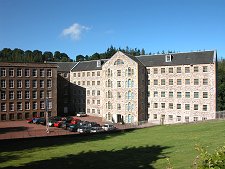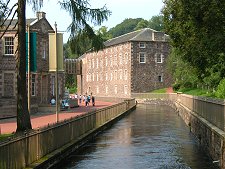 New Buildings and Nursery Buildings |
New Lanark is a remarkable place. The village was built from 1785 in a previously inaccessible gorge of the River Clyde a mile south-west of Lanark. Here it could take advantage of the tremendous power of the fast flowing river. The village's cotton mills, for much of their life the largest in Scotland, continued to operate for nearly two hundred years until their closure in 1968. Since 1974 the New Lanark Conservation Trust has been working to restore the village to what you see today: an achievement culminating in the inclusion of New Lanark in UNESCO's list of World Heritage Sites on 14 December 2001.
The process of natural power and beauty being harnessed in support of industry is remarkable, principally because of the scale of the ambition realised at New Lanark. This impresses 21st Century visitors: it must have been truly wondrous to those who saw it at the end of the 1700s.
But if the scale of the ambition realised in creating New Lanark was amazing, it was easily surpassed by the scale of the ambition realised in turning the vast and nearly derelict industrial wasteland of the early 1970s into the imposing, almost beautiful, complex that is New Lanark today.
So New Lanark is remarkable both for being built at all, and for continuing to exist today. There are two further ways in which it is remarkable. The first lies in the motives behind those who developed New Lanark.
New Lanark was created principally by David Dale, who ran it from its inception in 1785 until New Year's Eve 1799. David Dale's more famous son-in-law, Robert Owen, took over management of New Lanark on 1 January 1800, and ran it until December 1824. He coupled a strong appreciation of the principles and application of capitalism with a growing awareness of the importance to his business of the wellbeing of his workforce.
From 1 January 1814, when he acquired more enlightened partners, Robert Owen undertook an experiment at New Lanark that amounted to little less than a social revolution, introducing ideas like childcare, education, healthcare and cooperative shopping that helped change the world.
But by far the most remarkable thing about New Lanark is the way the industrial history, the social history, the superb restoration and the beautiful natural environment have been brought together to produce a truly living and thriving village with a wide range of attractions for visitors. A visit to New Lanark should be on everyone's list of "five things you must do in Scotland".
Our coverage of New Lanark is divided into a number of separate pages:
Visitor Information sets out the key facts including contact information, prices, opening hours, location and access.
Visitor Centre covers the core of the visitor attractions at New Lanark including the Visitor Centre, the New Millennium Experience and Mill 3.
Other Attractions looks at Robert Owen's School, the Millworkers' House, Robert Owen's House, the Village Store and other activities on offer.
Early History & Robert Owen includes the setting up of New Lanark by David Dale in 1785 and the period of Robert Owen's involvement until 1824.
Later History & Regeneration sets out the story from 1824, and particularly the regeneration of New Lanark from 1974.
New Lanark Mill Hotel focuses on the hotel housed largely in the restored Mill 1.
 The Rooftop Garden |

|
|
|
Visitor InformationView Location on MapWhat3Words Location: ///powder.orbit.elect Visitor Information Page |
 Counting House and Caithness Row |
 River Clyde and Double Row |
 Seen from the Falls of Clyde Footpath |
 Robert Owen's House & Village Hall |





